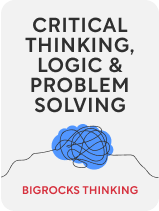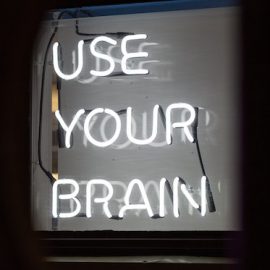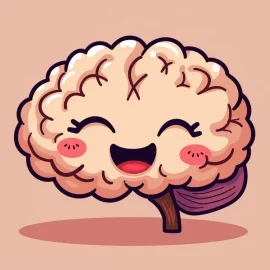

This article is an excerpt from the Shortform book guide to "Critical Thinking, Logic & Problem Solving" by Bigrocks Thinking. Shortform has the world's best summaries and analyses of books you should be reading.
Like this article? Sign up for a free trial here.
Do you apply critical thinking to problems that come your way? Could you use a step-by-step process?
In Critical Thinking, Logic & Problem Solving, Bigrocks Thinking explains how you can enhance your critical thinking and problem-solving abilities to improve your learning, your work, and your personal life. They share four steps for critical thinking that you can apply to any situation.
Continue reading to learn about these four critical thinking steps.
The 4 Critical Thinking Steps
The authors share the following steps for critical thinking: gather information, analyze your information by constructing arguments, evaluate your arguments by testing them, and assess your critical thinking process so that you can improve it. We’ll review each step in detail. But, first, let’s look at what critical thinking is.
The authors define critical thinking as the ability to use specific thought processes to understand concepts, solve problems, and communicate effectively. They argue that critical thinking is not an inborn trait but rather an ability that can be cultivated and honed. Practice is the most important factor in cultivating critical thinking.
Everyone can make use of critical thinking in their daily lives, including in school, the workplace, and your personal life and relationships. For instance, you might apply critical thinking to decide whether or not you should get a pet or to make a convincing case to your boss for why you deserve a raise.
(Shortform note: In Thinking, Fast and Slow, Daniel Kahneman describes two types of thinking, system 1 thinking and system 2 thinking. System 1 thinking is automatic and involuntary, and it’s often based on biases or previous experiences. System 2 thinking is a conscious process of focusing attention on the information being processed, and it matches up closely with the definition of critical thinking. As Kahneman explains, lazy system 2 thinking results in faulty logic, so it’s important to make a conscious effort to think deeply about new information and avoid unthinkingly accepting the conclusions of system 1.)
The authors detail four steps for critical thinking, which we’ll explain next:
- Gather information
- Analyze
- Evaluate
- Keep improving
Step 1: Gather Information
According to the authors, the first step to critical thinking is gathering information. It’s impossible to think critically about information you don’t have.
The authors explain that, to gather information, you should first identify the topic or question you’re dealing with as well as the circumstances or context surrounding it. Once you understand the parameters of your inquiry, you can begin researching it. To do this you’ll need to gather data, perspectives on the issue, and any additional information that could help you in your thinking process.
As you’re gathering information, assess its usefulness and credibility. According to the authors, not all information is equally useful, and you should also be aware of what information pertains to your inquiry and what information can be ignored to save you time and effort. For every piece of information you gather, ask yourself if it’s relevant to the subject of your thinking.
Finally, make sure you’re getting your information from reliable sources.
Checking Sources for Reliability
To ensure you’re using reliable sources, the authors recommend the following:
- Learn to identify real news versus fake news. Discuss different media sources with others and help each other distinguish between accurate news and things like sponsored articles.
- Analyze your sources to ensure their authors aren’t making assumptions but rather are using reliable data to back up their claims.
- Assess the authority of your source. Is this source an expert on the subject? Is it from a reputable media outlet? Does it explain where it got its information?
Checking Sources for Bias
Biases are errors in thought processing that result from generalizations the brain makes. These generalizations can help you make decisions more quickly, but they can also negatively impact your critical thinking. Biases are often impossible to avoid, but being aware of the biases in your sources can help you avoid them in your own thinking.
The authors list several different types of biases, including:
- Anchoring bias means being more likely to believe information that you hear first over information you gather later.
- Confirmation bias is the tendency to give more credence to information that confirms what you already believe and dismiss information that isn’t in line with your beliefs.
- The halo effect is when you have a positive view of someone or something, and this leads you to view their opinions or claims more positively.
- The Dunning-Kruger effect is when you put too much faith in your own abilities.
Checking for Logical Fallacies
A fallacy is a misunderstanding that interferes with your reasoning. Some common fallacies include:
- The middle ground fallacy—When there are two opposite options, you assume that the compromise between the two must be correct. However, if either of the opposite options is incorrect, then the middle ground will also be incorrect.
- False cause—You confuse correlation with causation. Two things that co-occur may not mean that either one caused the other. It’s possible that both factors are caused by a third variable.
- Anecdotal evidence fallacy—This fallacy involves using anecdotes, or isolated examples from real life, as evidence for a larger argument when more general evidence may not support that argument.
Step 2: Analyze
Now that you have your relevant information and you’ve assessed its reliability, the next step of critical thinking is to review the information you’ve gathered to see what arguments you can make from it. To do this, you’ll use inductive reasoning, which consists of three steps:
- Identify patterns in your information. Patterns help us understand information and form arguments.
- Identify questions that need to be answered. This will tell you what type of argument or solution you need to come up with. Your question or problem should not only lead you to an answer but should also help you learn more information. For that reason, you should avoid yes or no questions, as answers to these will be simplistic and may not yield any real solutions. Additionally, use neutral language when forming your question to avoid biasing the answer.
- Draw conclusions. Use the information you’ve gathered to draw inferences. These inferences serve as logical foundations for the formation of your arguments.
Step 3: Evaluate
Once you’ve formed an argument based on your analysis of your information, it’s time to test that argument and evaluate its validity. The authors recommend that you use deductive reasoning, the process of going from a theory to a hypothesis and testing it to see if it’s supported by evidence.
For example, say you’ve used your inductive reasoning process to analyze data on how listening to classical music affects people’s moods: You notice from the data that people in a study reported feeling happy after listening to classical music. You conclude that listening to classical music makes people happy, and this is your theory.
You will then use deductive reasoning to test this theory. From your theory, you form the hypothesis that if you play classical music for someone who is sad, it will make them happier. You test this hypothesis by playing classical music for someone who is sad. If the person feels happier after listening to the music, you now have a piece of supporting evidence for your hypothesis. However, if you find that the person doesn’t feel happier after listening to classical music, you disproved your hypothesis and theory.
| Replicating Your Results to Strengthen Your Hypothesis Reproducing the results of a study to strengthen a hypothesis is an essential part of reasoning and the scientific method. Because deductive reasoning can only provide evidence for a hypothesis being true and can’t definitively prove that it’s true, it’s important to continue testing a theory even if your deductive reasoning process has provided supporting evidence. However, sometimes the nature of a study or experiment makes it difficult or impossible to replicate. In modern science, this has led to a replication crisis in which many hypotheses can’t be tested effectively because the results of previous experiments can’t be reproduced. Consequently, hypotheses that may be true can’t become part of the scientific body of knowledge because they can’t be effectively validated. In your own reasoning process, you may face a similar issue if you find that certain variables that you can’t control are affecting the results of your reasoning—especially since, unless you’re a scientist, you’re probably gathering your information from informal sources rather than strictly controlled experiments. While being unable to replicate the results of your reasoning doesn’t disprove your hypothesis, you should keep in mind that it hasn’t been tested thoroughly enough to prove it. |
Step 4: Keep Improving
Now that you’ve used your data to form and test a hypothesis, the next step is to note things you did correctly or that made the process easier and remember them for next time. If you do this, you’ll constantly improve your critical thinking.
(Shortform note: When you first begin, you may find that this is the most difficult step for you to complete. This is because reflecting on your thinking—also known as metacognition—takes a lot of mental energy and may also take a long time. However, as you continually reflect on and refine your learning and thinking processes, this step will become easier, and, eventually, you may begin to do it without having to consciously think about it at all.)

———End of Preview———
Like what you just read? Read the rest of the world's best book summary and analysis of Bigrocks Thinking's "Critical Thinking, Logic & Problem Solving" at Shortform.
Here's what you'll find in our full Critical Thinking, Logic & Problem Solving summary:
- A step-by-step guide for improving critical thinking and problem-solving skills
- Tips for conducting better research and finding reliable resources
- How to improve your communication and storytelling skills






